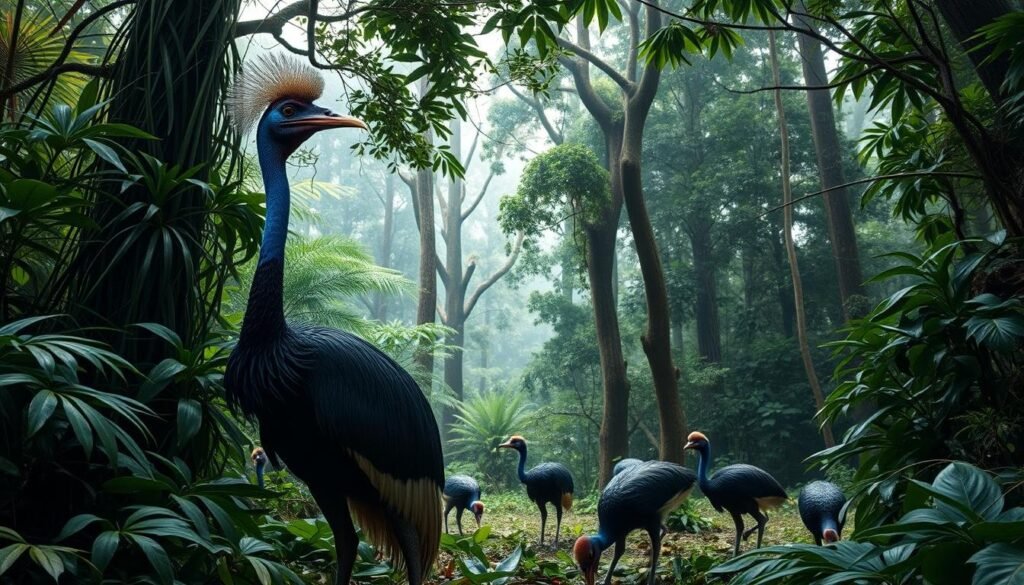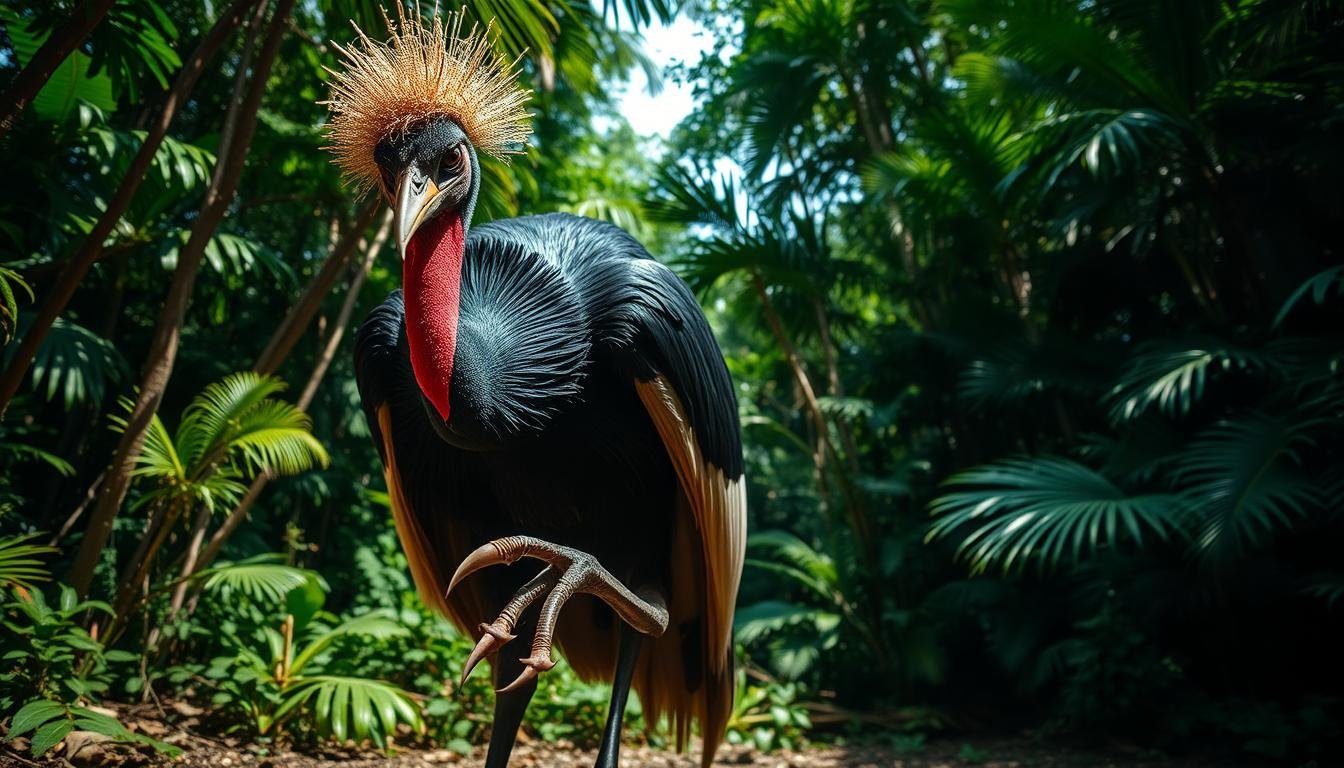Why the Cassowary is Considered the Most Dangerous? The cassowary is a large, flightless bird found in Australia’s rainforests and New Guinea. It has a unique casque, or crest, on its head and strong legs. This makes it a powerful creature.
The cassowary can kick with great force, causing serious injuries. There have been cases of cassowary attacks on people. It’s important to know how to stay safe around them.
Let’s dive into why the cassowary is known as one of the dangerous birds in the world. You’ll learn how to avoid them and what to do if you meet one.
Contents
- 1 Meet the Cassowary: The Prehistoric-Looking Bird of the Rainforest
- 2 Unique Features of the Cassowary’s Casque
- 3 Why Is the Cassowary the Most Dangerous Bird in the World?
- 4 Understanding Cassowary Behavior
- 5 Documented Cassowary Attacks on Humans
- 6 Cassowaries in Context: Ecological Importance and Conservation
- 7 How to Stay Safe Around Cassowaries
- 8 Conclusion: Why the Cassowary is Considered the Most Dangerous?
- 9 FAQ
- 9.1 What is the cassowary’s typical habitat?
- 9.2 What makes the cassowary’s kick so deadly?
- 9.3 How can you avoid confrontations with cassowaries?
- 9.4 What is the cassowary’s role in its ecosystem?
- 9.5 What are some safety tips for encountering cassowaries?
- 9.6 Why are conservation efforts crucial to the cassowary’s survival?
- 9.7 How does the cassowary’s casque contribute to its behavior?
Meet the Cassowary: The Prehistoric-Looking Bird of the Rainforest
In the rainforest, the cassowary is a standout. It’s a big, flightless bird with a scary look. You’re about to learn about this ancient-looking bird that lives in Australia and New Guinea’s rainforests.
The cassowary has a unique casque, or crest, on its head. This crest is thought to help with communication and finding a mate.The cassowary’s casque is a remarkable example of evolutionary adaptation, making it different from other birds.
Unique Features of the Cassowary’s Casque
The cassowary’s casque is more than just a look. It’s also a topic of study for bird experts. It’s believed to help with social interactions. The casque is made of keratin, like human hair and nails, and is light, which is handy for the cassowary.
The cassowary also has strong legs and sharp claws. These are not just for looks; they help protect it from predators. Its home, from Australia’s rainforests to New Guinea’s tropics, faces threats from deforestation and climate change. This makescassowary conservationvery important.
There are efforts to save the cassowary and its home. These focus on keeping the rainforest healthy. By learning about the cassowary’s role in its habitat, we can help conservation. The cassowary’s survival depends on its habitat, showing whycassowary habitatpreservation is key.
Exploring the cassowary’s world shows it’s not just interesting but also vital to its ecosystem. Saving the cassowary and its home is essential for the rainforest’s balance.
Why Is the Cassowary the Most Dangerous Bird in the World?
The cassowary’s deadly kick can reach speeds of up to 30 miles per hour. This makes it a force to be reckoned with.
The cassowary’s powerful legs and sharp claws are the main reasons it’s seen as the most dangerous bird. Its kick can seriously hurt humans, and in some cases, it can be fatal.
During mating season, cassowaries become more aggressive. Their territorial behavior becomes more pronounced. When they feel threatened or when they’re protecting their young, they can become deadly.
Understanding Cassowary Behavior
Cassowaries are generally solitary animals and have a large territory. They mark their territory with their distinctive calls. When they encounter other cassowaries or potential threats, they can become aggressive.
| Reasons for Cassowary Aggression | Description | Consequences |
|---|---|---|
| Mating Season | Increased testosterone levels lead to aggressive behavior | Attacks on humans and other animals |
| Territorial Protection | Defending territory from perceived threats | Violent confrontations with humans and other cassowaries |
| Feeling Threatened | Responding to perceived danger or surprise encounters | Defensive attacks, potentially causing injury |
To minimize the risk of cassowary attacks, it’s essential to understand their behavior. Exercise caution when in their territory.
By being aware of the cassowary’s aggressive behavior and taking necessary precautions, you can reduce the risk of a potentially deadly encounter.
Documented Cassowary Attacks on Humans
Encounters between humans and cassowaries are rare. However, there have been cases where cassowaries have attacked people. These attacks usually happen when the cassowary feels threatened or is protecting its young.
The cassowary’s aggressive behavior can be caused by several factors. Being fed by humans is one of them. It’s crucial to maintain a safe distance and never feed cassowaries in the wild.
There have been documented cases of cassowary attacks causing serious injuries. The table below summarizes some notable incidents.
| Year | Location | Circumstances | Injury |
|---|---|---|---|
| 2019 | Queensland, Australia | A man was feeding cassowaries. | Severe kick injuries to the leg. |
| 2017 | Florida, USA (captive cassowary) | A cassowary attacked its owner. | Fatal injuries. |
| 2004 | Queensland, Australia | A man approached a cassowary’s nest. | Serious kick injuries. |
To avoid cassowary attacks, understanding their behavior is key. Cassowaries are shy but will defend themselves if threatened. Keeping a safe distance and being aware of your surroundings in cassowary habitats can reduce the risk of an encounter gone wrong.
By understanding cassowary behavior and taking precautions, you can safely enjoy their natural habitats. This way, you ensure your safety and the safety of the cassowaries.
Cassowaries in Context: Ecological Importance and Conservation
Cassowaries play a big role in their rainforest homes. They help spread seeds by eating fruit and then dropping the seeds in new spots. This helps plants grow and diversify in the rainforest.

Cassowaries keep their ecosystems balanced in many ways. They help new plants grow by spreading seeds. This makes the rainforest more complex, supporting many animals. They also control plant growth by eating certain plants.
Protecting cassowaries and their homes is key. Conservation efforts include:
- Habitat preservation: Keeping rainforests safe for cassowaries is essential.
- Research and monitoring: Scientists study cassowaries to help protect them.
- Community engagement: Teaching locals about cassowaries helps everyone live together safely.
Learning about cassowaries shows why we need to save them. By protecting their homes, we also save the rainforest’s biodiversity. Saving cassowaries helps keep ecosystems healthy and strong.
How to Stay Safe Around Cassowaries
Exploring areas where cassowaries live requires knowing how to stay safe. These birds are dangerous and can kick hard enough to hurt you badly.
To keep safe, always be aware of your surroundings. Stick to marked trails and avoid thick bushes where cassowaries might hide.
If you see a cassowary, keep your distance. Slowly back away if it comes towards you. It’s important to know when a cassowary is getting angry. They will lower their heads, raise their hackles, or make loud noises when scared.
- Never feed cassowaries, as this can make them associate humans with food, leading to aggressive behavior.
- Avoid running, as this can trigger a chase response from the cassowary.
- Keep pets on a leash to prevent them from provoking a cassowary.
If a cassowary attacks, protect your neck and head with your arms. Slowly back away and try to get to a safe place, like a car or building.
It’s crucial to respect the space of these dangerous birds for your safety and theirs. By being careful and informed, you can watch these amazing birds from a safe distance.
Conclusion: Why the Cassowary is Considered the Most Dangerous?
You now know about the cassowary’s special traits and its place in nature. Its strong kick and sharp claws make it a force to be reckoned with. Yet, by understanding and respecting these birds, we can live together peacefully.
Protecting the cassowary and its home is very important. By helping conservation efforts, you help keep the cassowary and its ecosystem safe. It’s also key to know how to stay safe around these birds, especially if you live near them or visit their habitats.
By valuing cassowary conservation, you help ensure this amazing species thrives for years to come. As we’ve seen, respecting these powerful birds and their environment is crucial for safe coexistence.
See Also: Why Are New Orleans Cemeteries Dangerous To Humans?
FAQ
What is the cassowary’s typical habitat?
The cassowary lives in the rainforests of Australia and New Guinea.
What makes the cassowary’s kick so deadly?
Its kick can go up to 30 miles per hour. This makes it very dangerous.
How can you avoid confrontations with cassowaries?
Knowing how they act and what they show can help. This way, you can avoid trouble.
What is the cassowary’s role in its ecosystem?
It helps spread seeds. This keeps the ecosystem balanced.
What are some safety tips for encountering cassowaries?
Be alert and watch for signs of anger. Know what to do if attacked.
Why are conservation efforts crucial to the cassowary’s survival?
Its home is being lost to deforestation and climate change. Saving it is key.
How does the cassowary’s casque contribute to its behavior?
Its casque, or crest, helps with talking and finding a mate.

Lorenzo Sloan is a safety advocate from Los Angeles who exposes hidden and everyday dangers through research-based blogging. With a background in social work, he aims to keep readers informed, cautious, and prepared for the unexpected risks around them.

